February/March 2018
In Search of a Tasmanian Tiger
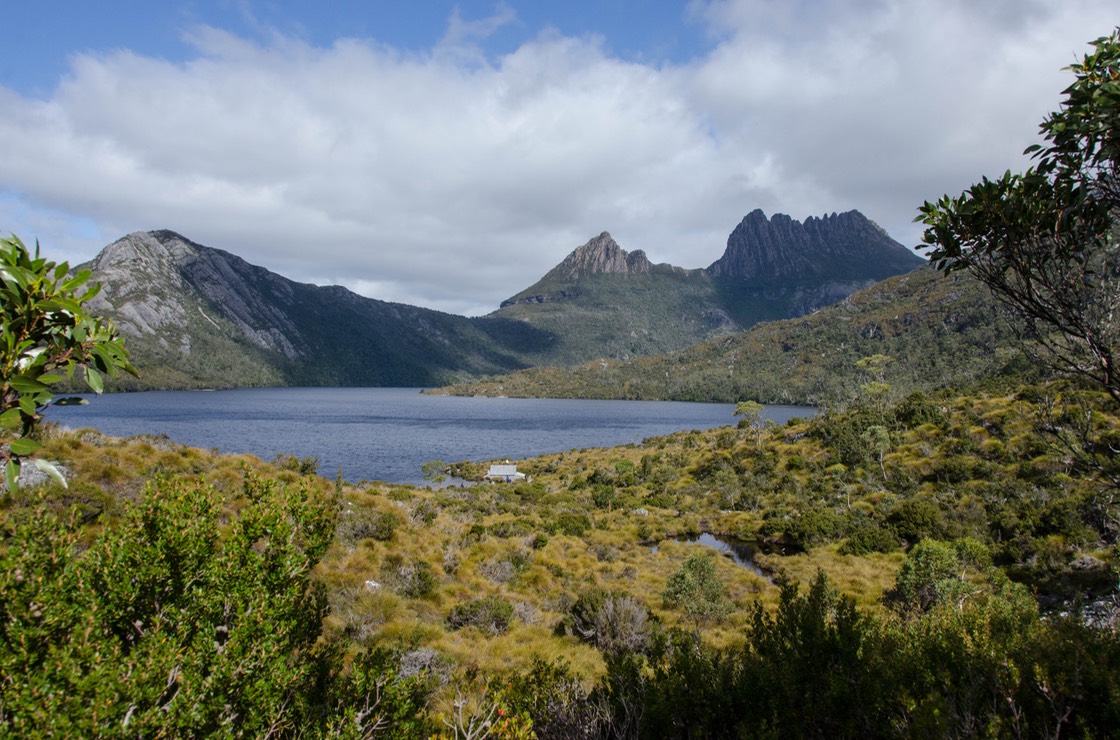
What’s the first thing you think of when the word Tasmania comes up? First is probably “where in the hell is….?” Second, perhaps the “ferocious” Tasmanian Devil, who’s a real creature after all, not just a cartoon. After that, if you’re familiar with this island off the south coast of Australia, maybe you think about hiking trails, lovely waterfalls, cute furry critters, great surfing; stuff like that. You may also have heard about convict slave labor, “more English than the English”, early explorers, and a pretty rough way to make a living. It’s all that, and more. So stay tuned.
You’ve got to be losing track, but we’ve been in Australia for almost 10 months now. Everyone we met along the way said you’ll love Tasmania, and ya gotta go. So here we are, just finishing up our six week stay and taking time to think about our experience. It was great overall, with lots of nice moments, but maybe less than anticipated in some ways too. We’re also thinking of how to respond to the old question: Was it worth it? Yes, of course! We’re very glad we came, we wouldn’t have wanted to miss it. As is always the case, each traveler must make his or her own journey; must experience each destination in their own way. As we once said about another country everyone loves to visit, Costa Rica, we had to find our own version of the place. Let’s see how this particular trip went for Team Tortuga.
The island of Tasmania lies south of the Australian mainland, off the coast of Victoria; you get there either by flying or taking a ferry, both of which leave from Melbourne. Having the Tiger in tow, we naturally took the boat, a ten hour trip on a nice big ferry. We chose to cross during the day, but overnight sailings are also available. The ferry terminal in Melbourne’s harbor is poorly situated for the crowds that get on the ship and there is terrible confusion while you wait to get in the queue for boarding. Cars, RVs, bicycles, caravans, motorcycles, huge trucks, you name it — all wanting to get on board and get out of the harbor, and all winding through the very upscale residential area that leads to the tiny-tiny couple of lanes that actually head out onto the dock.
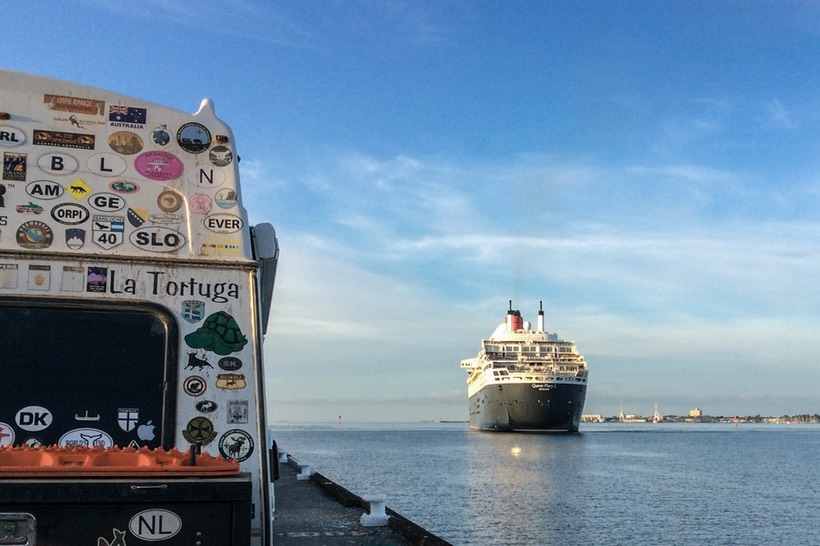
Such a mess, and our passage was additionally impacted by the enormous cruise ship Queen Mary 2 that wanted to dock right next to our ship — NOW; no, not after we departed — and which brought us to a complete halt for most of an hour. So our voyage across the Bass Strait to Devonport took even longer than expected. But it was a great opportunity to catch up on our reading.
Disembarking late that night, we were stopped by a nice fellow passing out sheets of paper that indicated the extent of the Quarantine Zone we had just entered. Whatever fruit we bought while in the Zone had to be dumped in bins when we left it. Seems fruit flies had recently been discovered here and work was underway to try and corral and eradicate them. A nuisance for travelers, but much worse for the locals. It made for a small but still significant complication for us as we arrived. We had not been able to bring any fruit or vegetables with us from the mainland and now had to calculate how long we thought we’d stay “in the zone.”
Tasmania is a huge fruit production area — it’s often called the Apple Isle — and this kind of problem affects both production and local sales. During our time here we passed in and out of the quarantine area several times, and trying to decide how many bananas or apples to buy and where to get them, to say nothing of those wonderful blackberries we saw on the roadside stands, made it harder to be spontaneous. But enough. The fruit here is wonderful and we have enjoyed lots of it. We’ve never had better strawberries.
We spent our first few days gathering ourselves and making plans. It always seems to be the way. We work so hard getting ready to get on the ship that getting to the dock on time turns into the only goal we achieve. So, settling in a cozy spot for a few days, we tried to figure out where we wanted to go here, and how to organize a logical route. We had friends joining us for part of our time, and we wanted to be on hand when they arrived.
We also had an unexpected fly in the ointment. Not a fruit fly thank goodness, just a normal bureaucratic paperwork sort of fly. We knew that our carnet (paperwork for the truck) was going to expire while we were in Tassie and not wanting to mess with it there we’d planned on having the new one sent to friends in Melbourne. Well… the carnet provider would have none of that thank you, as they were not willing for there to be a gap in coverage between the old and new carnets. This became a real hassle that would in some ways color much of our stay. We had to find someone on the island who could receive the new paperwork for us, and then we would have to take it to one of only two customs offices in the state in order to have the old one stamped out and the new one stamped in. Huge complications that took us running back and forth all over the island over the next month’s time. We breathed a sigh of relief when we finally got it all handled and the old, expired carnet mailed off to the carnet gurus in Illinois — hurrah! You don’t need to know all the details, but for now we’re good to go until March 2019 when we’ll need to figure out how to do all of it again in a different country.
Before, during and after all this we wandered the island of Tasmania. To the uninitiated, Tasmania (Tassie to most) is an island shaped rather like a lumpy butterfly that’s been eating too much and is very fat in the middle. But Devonport is at the head, along the northern coast; there are two large bulges on the sides representing the east and west sides of the island; and then the whole mass narrows toward the bottom and there you find Hobart and surrounds. TMI, most decidedly so.
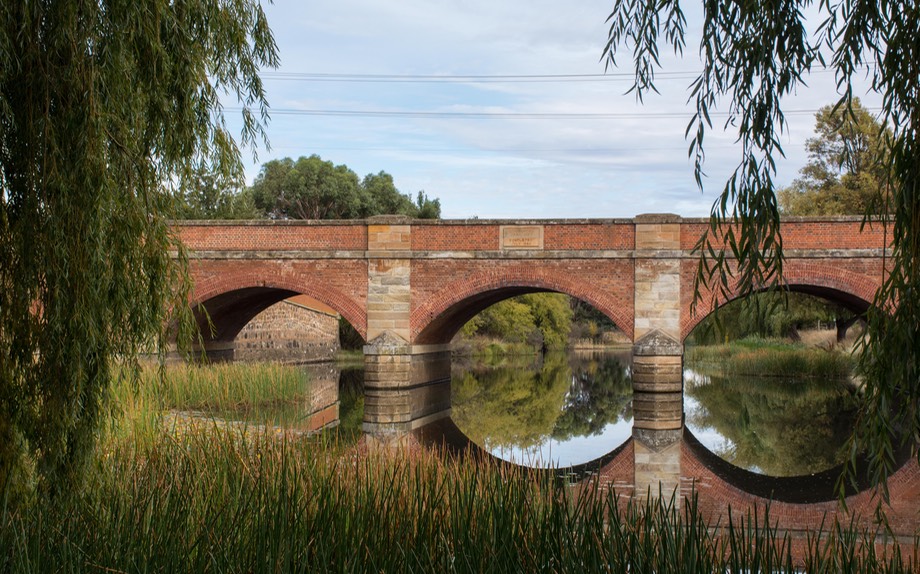
Having landed in Devonport, we began by making our way south through the central highlands, up over 1100 meters, heading down to Hobart, the capital. Our friends were flying in there, and we wanted to be there to greet them. This is a really nice area, and it reminded us of the Scottish Highlands. Not surprisingly, it had been settled by Scots, and you can immediately tell. The first golf course in the southern hemisphere greets you as you enter town. Just a few days ago, more than a month later, we came back through these mountains again, heading north to the ferry; by then the trees were turning yellow for autumn, and it was quite a sight.
After meeting up with Toni and Berit, we spent the next day deciding what we wanted to do together. As they only had two weeks here, and would be moving more quickly than we needed to, we pinpointed areas of common interest and then spent the next few days exploring some of the southern and eastern parts of Tassie. We all wanted to see as many of the wild animals as we could, and visit the beautiful beaches and small islands off the coast.
We had a super time there together. We took a very pretty drive down the coast from Hobart and picked up the ferry to Bruny Island, a great area. It’s actually two smallish islands connected by a long isthmus, and chock full of beautiful beaches. Wandering along, we found a monument to where Captain Cook had “watered” his ship — in January of 1777. I thought that was pretty cool. There were lighthouses to visit, the occasional wild rabbit to scare off (not very many of them on this island), marvelous scenery, a chocolatier to check on and an excellent dinner at the Salty Dog in Kingston Beach back on the mainland at the end of the day.
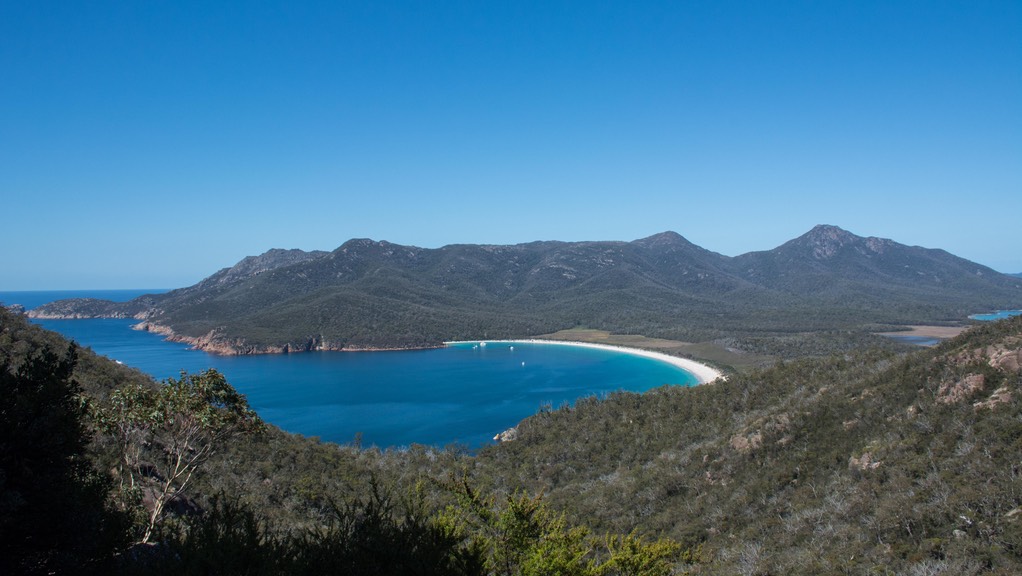
Our friends wanted to stay in the Hobart area for a couple of days longer, to see some of the city as well as to learn about the country’s notorious convict history. There are the remains of several prisons on the island, constructed back in the early settlement days, and there was much to explore right in the Hobart area. We decided to join up again in a few days, a bit further up the east coast, where we were all anxious to explore the Freycinet Peninsula.
Freycinet National Park is one of Tassie’s great destinations. It’s a long peninsula, again filled with pretty views and beaches, famous Wineglass Bay to hike up and take a look at, and an incredible rocky coastline to enjoy. We wore ourselves out trying not to miss anything, but compensated by camping along a beautiful inland lagoon.
Our last day together we spent at an animal sanctuary north of the little town of Bicheno, on up the east coast. Toni and Berit had already visited another sanctuary, closer to Hobart, but I think they enjoyed this experience as much as we did.
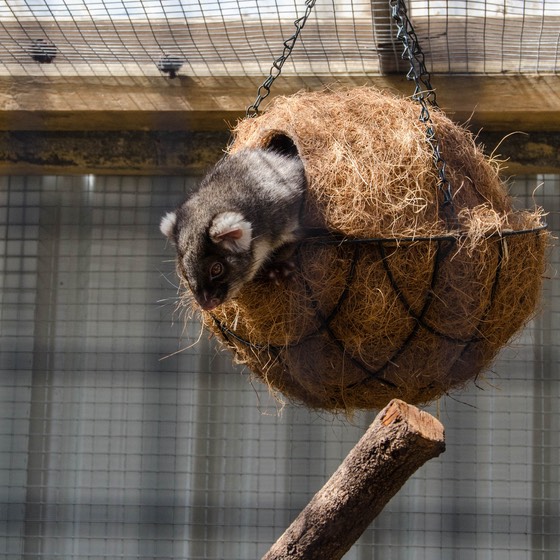
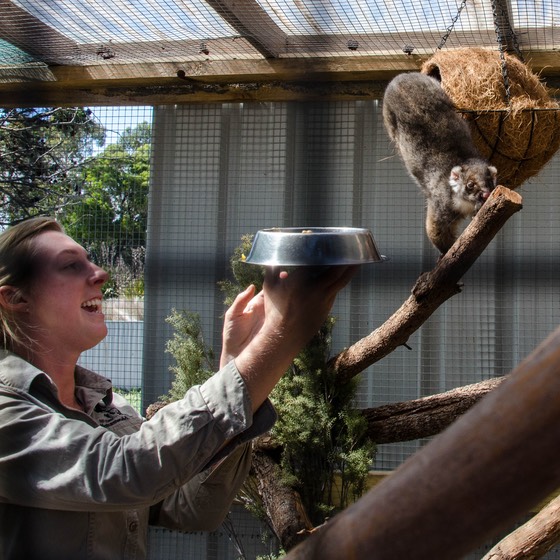
Natureworld is a private facility that provides a home for damaged animals, returning them to the wild when possible, and providing a permanent home for them when necessary. They also do some breeding and are involved in a cooperative program working to improve the genetic diversity of the Tassie Devil population. The park is large enough to allow for different areas for the animals; one area for those being prepared to return to their natural life in the wild and thus cannot be allowed human contact, and separate areas for the ones who will never be strong enough to live on their own. These animals and birds can be cared for while also being shared with visitors who can learn about them and take home memories of the experience. There was a walk-in aviary where we were able to see up close many of the birds we’d been hearing (and seeing from afar). We aren’t birding people really, but we have loved the sights and sounds of the wild birds in Australia and it was really cool to get close to these birds without having them fly away. They were beautiful.
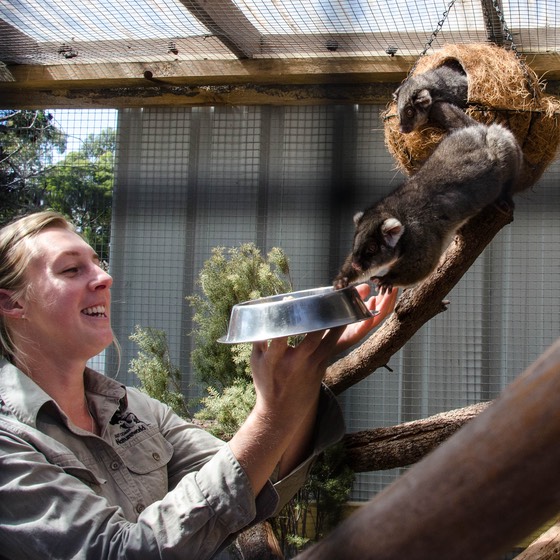
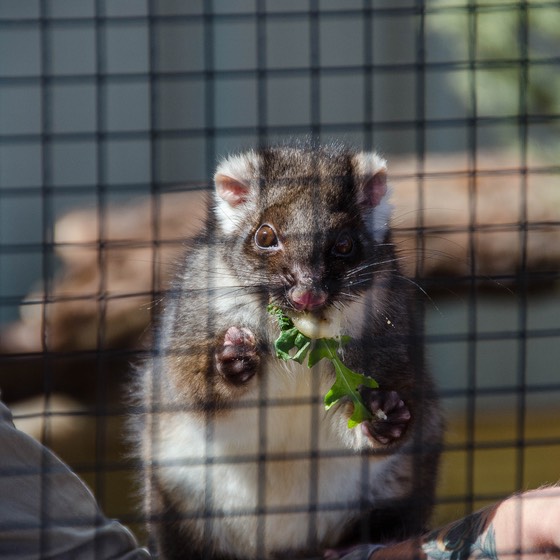
Various enclosures had Tasmanian devils, emus, echidnas, lizards, quolls, various little squirrel-like critters… and wombats. We think most visitors are anxious to see the Tassie Devils; but for us, it was the wombats who captured our hearts. We were able to pet them, and they are just so cute and cuddly! We think they are the best of the best here in Tasmania! The people working at the facility were extremely knowledgeable, easy to talk to, and the animals obviously loved them. We can’t actually remember which critters these are here being fed by Sarah, but we think the sequence is fun. Out in the open grassy fields there were kangaroos and wallabies, and you could buy the appropriate food to feed them — out of your hand. It was a wonderful place to visit. We were in love.
At the end of the day, Toni and Berit needed to start moving more quickly around the island. We made hopeful plans to catch each other a few days later, gave big hugs, and waved goodby. If it turned out that we couldn’t manage more, we sure felt we’d done a good job of exploring and having a swell time together. Once we’d parted company, we began wandering more slowly, moseying up the eastern coastline, spending nights along the edges of lagoons and bays, enjoying pleasant weather and lots of sunshine. What’s not to like?
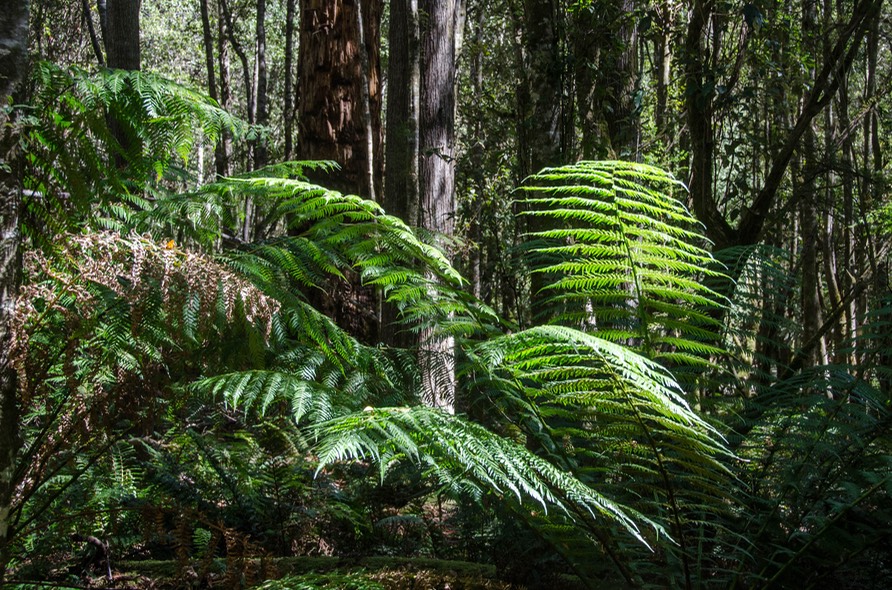
Looping inland a bit, we stopped at Evercreech Forest Reserve to see the ferns and white gum trees and forest, on one of the lovely walks recommended to us by other friends. About these walks — Tasmania has put together a nice brochure named 60 Great Short Walks, and they really have been super. They pinpoint neat things you can walk to get to, they don’t take a huge amount of time, and the difficulty of each is evaluated and explained. It’s terrific. Over our six weeks here, we probably took 15-20 of them, each a real pleasure.
We visited Ben Lomond NP, one of the spots on the island where occasionally there is enough snow in the winter for skiing. We were there because of a great drive to the top of the mountain, called Jacob’s Ladder, which is absolutely killer. Steep, winding, narrow, the perfect road for an adventurous drive. At the top we got to enjoy extraordinary views, and the rock columns, in some places referred to as “organ pipes”, were very dramatic. And at the top of this thousand meter climb there were many alpine plants and a lovely bog to enjoy, and more memories of Scotland. Super-duper.
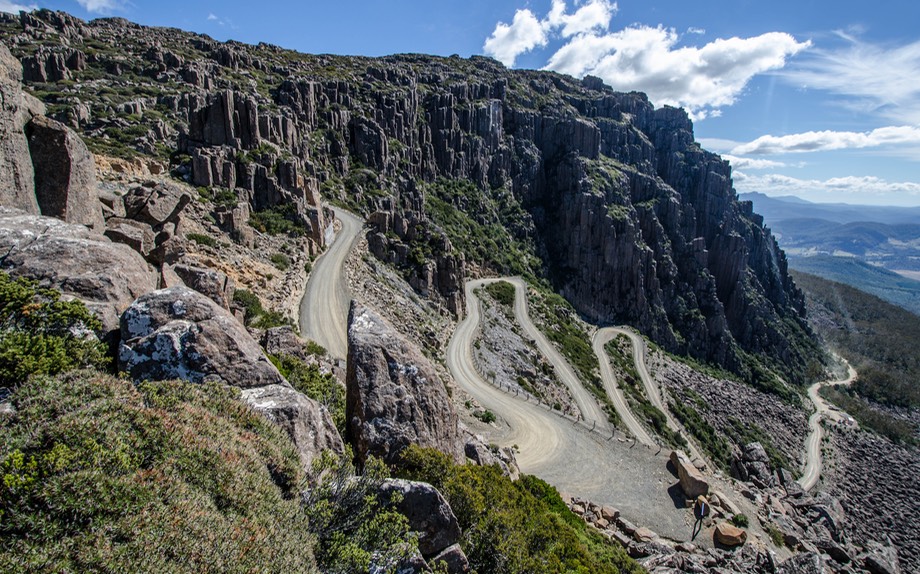
This eastern area is nice country, not all that dramatic, but very pleasant. It is drier than usual now, as they’ve had two years of drought, even having to cart in water at times. There still are many falls, although sometimes they aren’t as spectacular as the pictures would have you expect. And the forest floor is sometimes dry and dusty. But we weren’t complaining; we were having a fine time.
On one lovely day’s drive we visited the small town of Ledgerwood, home to some wonderful wood carvings and a very moving story. In 1918 the town planted nine cypress trees to honor the seven local boys who had been killed in the war plus one in honor of the ANZAC troops who’d served and one for Gallipoli. In 2001 the now ancient trees were declared dangerous and scheduled for removal. Unable to face the loss of the memorial grove of trees, the town met, gathered funds, and proceeded to have the enormous trees trimmed back to the bare trunks; then they had those trunks carved and finished into actual memorial sculptures featuring the likenesses of each of the men along with their families who’d been left behind. We found it to be a truly moving memorial and a lovely group of sculptures. A tiny town which had stepped up and done a good thing — twice — a real highlight for sure.
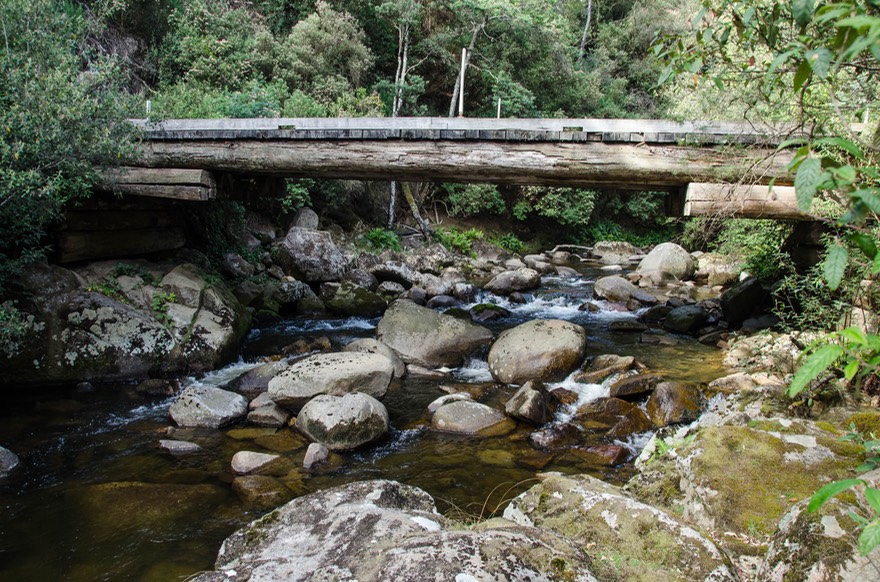
Continuing on that same day we trekked to three different sets of waterfalls before settling in a tiny roadside spot surrounded by tall trees, ferns, and the burbling South George River. Lilydale Falls, Ralphs Falls, and St Columba Falls were each pretty in their own way although a bit down on water flow this late in the season. Each of them was reached by a short, pleasant walk through ferns and undergrowth below a tall canopy of eucalypts. Despite the general aridness of the climate, the shade is such in these forests that moss and fungus combine with the ferns to create an amazingly lush environment.
Here, as is true all over Tasmania, the unprotected rural forested areas are continually being harvested, with plantations having taken the place of “real” forests; as an area is clear-cut, new trees are planted in neat, tidy rows, ready to be cut down in a few decades by the planters’ sons or even grandsons. The clear-cut areas are pretty dismal looking of course, and it takes the new trees at least a decade to bring some semblance of health to an area. Quite sad in a scenic sense, but reforestation is important in Tasmania; and while we saw logging in many areas we also saw plenty of evidence of sincere replanting efforts and signage describing the reforesting programs. Foresting vs Preservation is an active issue here, with much of the western part of the island set aside in protected areas of different types, including huge tracts of land that have been granted World Heritage status. Presumably you can find unhappy folks on both sides of the argument, but to the traveler it seems that they have worked things out and found a pretty good balance.
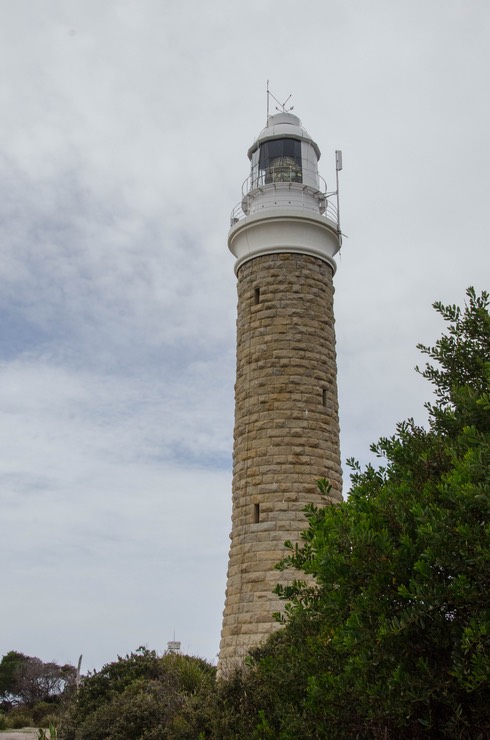
We returned to the coast up near the northeast corner of the island. We’d come to see the Eddystone Lighthouse, which was uniquely a joint project of the government and an Aboriginal group, which was in charge of maintaining it and running the show. It was nice to see some Aboriginal presence here. It’s a nice spot, and forms the easternmost point of Tasmania. It also sits sort of at the head of a very famous area, the Bay of Fires.
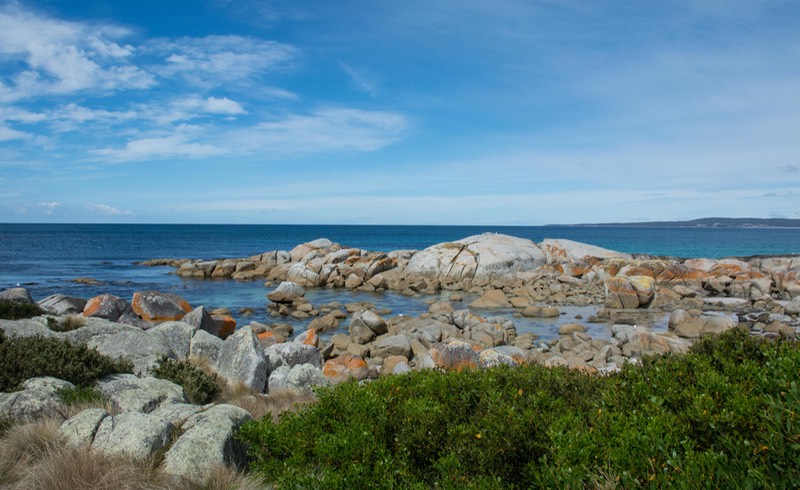
These days the Bay of Fires seems to be a big attraction because of the bright colors of the rocks, but the story is that early explorers named the bay after the evening fires of the local indigenous tribes that lived in the area. There were many indigenous people here then, and many fires, which were seen by a passing ship that named the bay. Regardless, it’s a beautiful and dramatic area, and we spent several days wandering in the region, enjoying the views and the warm waters of the bay (well, after you got used to the water it seemed warm). It’s a great area to visit.
Having completed a thorough tour of the northeast, it was time to get further inland and to head back down and check out the various small cities along the central core, the spine of our butterfly. These are early settlements, small towns, all on or near the main north-south highway that splits the island in two. We had a lovely time in Richmond, which we actually visited three different times as we took care of the carnet business. It’s a beautiful spot, very English, a small village with a charming bridge over the river, complete with ducks and geese and flowers along the banks. You’d love it.
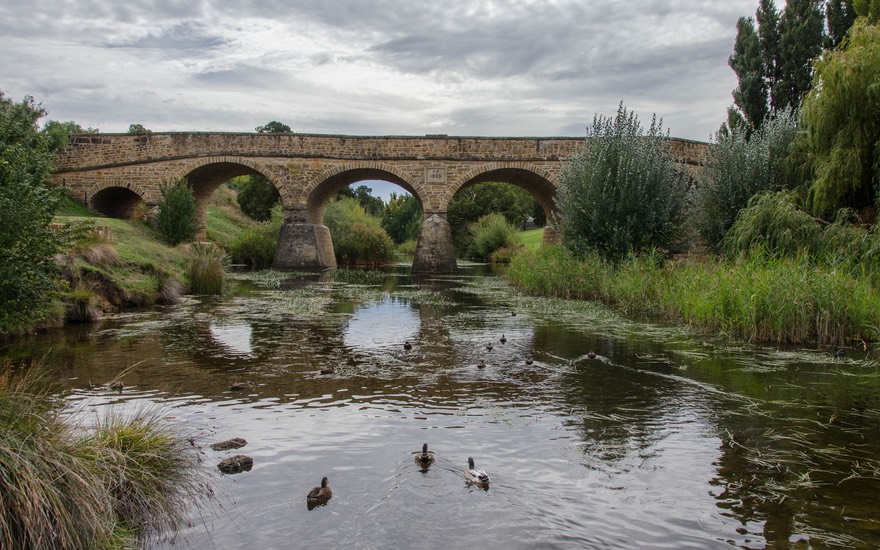
We also stopped at Ross, a famous early wool center, and Campbell Town; both also have great bridges to look at, nice early churches, and atmosphere forever. They are charming. These three towns date from the early nineteenth century and their wonderful brick and stone bridges are all dated in the mid 1830s.
It was time to start moving west across the top of the island. Many of the areas we wanted to see were in the “wild” western part and we didn’t want to have to hurry. Amazingly, we were beginning to think that our six weeks wasn’t any too long!
We made a nice stop in the city of Launceston. It was where our new carnet was waiting for us, for one thing, but it’s an interesting city and has several places we wanted to visit. There is a lovely city park (veddy, veddy English) to enjoy, with a gazebo, conservatory, and beautiful gardens — we got a swell London fix. Also, an organization called Design Tasmania, which showcases the island’s woodworking talent, has a gallery on the grounds. And, not to be outdone, for some odd reason there’s not only a small Japanese teahouse, but a permanent exhibit of Japanese macaques romping around and looking for attention, albeit behind glass. A most interesting spot.
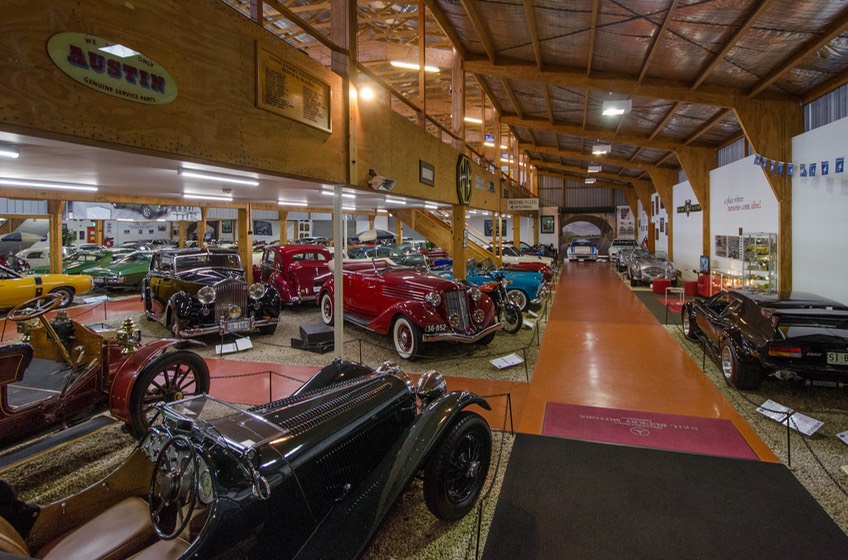
Across from the park lies the very interesting and worthwhile National Automobile Museum of Tasmania. This is a very nice spot. It houses an ever changing collection of cars, none of which are actually owned by the museum. We’ve seen museums like this before and they can be a bit spotty due to lack of variety or condition of the exhibits, but not this one. No sir. There was a great mix of British, American and Australian cars on display as well as a small but interesting group of motorcycles. All housed in an old but lovely building. You can visit our photo gallery of this museum at Motor-Museums.com. Our time at the museum topped off an excellent visit to a nice city, the second largest in Tassie.
A bit northeast of Launceston, up on the coast, lies Narawntapu NP, home to Forrester kangaroos and other interesting critters. We went up and spent a night and day, enjoying solitude, animals, water lapping close to the shore we were sleeping near, and a chance to possibly see some shore birds. Unfortunately, the trail out to the bird hide was rather overgrown, and each person we talked to as they returned from heading there announced loudly that there were snakes, lots of snakes. We eventually gave in to our heebee jeebees and turned back. Another time. We had also come
out with high hopes of seeing wombats in the wild, as advertised, but the actuality was that they’d recently succumbed to a nasty type of mange and were no longer to be seen in the park.
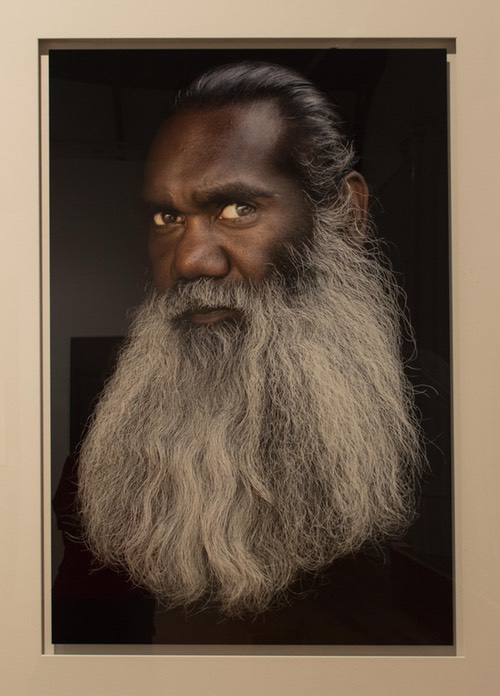
We didn’t need a second city fix in this lovely rural area, but decided to stop in at Devonport anyway. There was a very nice Regional Art Gallery we’d seen a brochure for; we took an hour and wandered it, enjoying every minute. They had a temporary exhibit of portrait photography that was quite stunning, including one of an Aboriginal man that had been on the cover of the brochure. It was really special. The exhibit was on loan from the National Portrait Gallery in Canberra and served to renew our desire to visit the capital city before we leave Australia.
We also stopped at the Devonport Arboretum, because we’d gotten the word that there might be platypuses on parade. We spent some lovely time there; the arboretum is beautiful and quite enjoyable. But the platypus viewing didn’t happen; well unless you count the possible, maybe, do you think, I dunno, disturbance in the water near the hide. Sorry, Diana! We keep looking.
Next stop on our wanderings to and around the western side of Tasmania was a trip up to Cradle Mountain, one of the most visited sites on the island. And understandably so. It was raining and threatening to snow when we arrived, but nothing bad ever quite happened. It reminded us that you cannot rely on the weatherman’s promises that the day you’ve picked is going to be a good one.
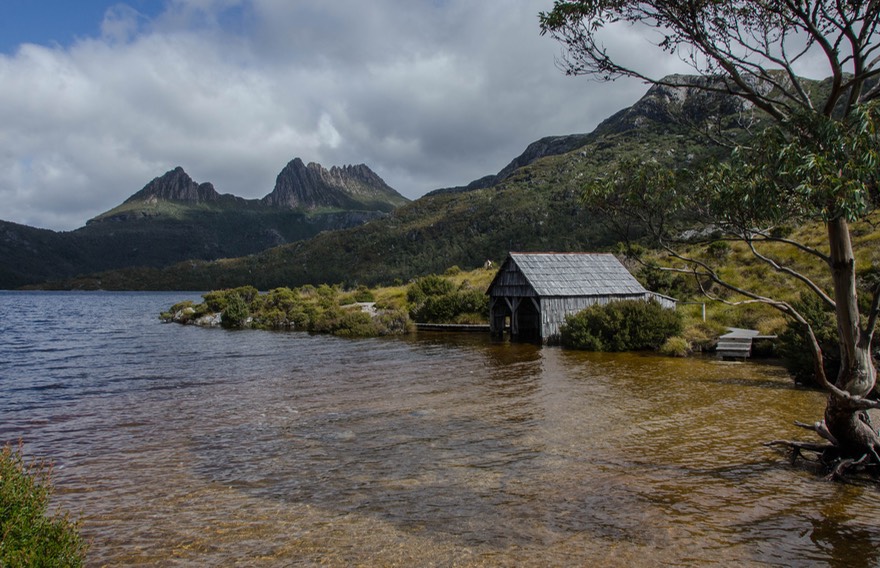
We really enjoyed being there, however. We took several walks, exploring the alpine bog, the mountains, the look of fall everywhere, the mosses on all the forested trees, all that good stuff. We took the required shuttle bus up to Dove Lake, location of the iconic picture of the mountain (of which we must have taken a dozen shots apiece), and thought about the classic several-day backpacking trip that starts there and the wonderful alpine areas to be seen on such a trip. In another life. It was a great day.
After leaving the area, we kept moving west. We had been told about extraordinary honey to be found in northwest Tasmania, Leatherwood by name, and we’d located a farm that specialized in it. We found it at the Blue Hills Honey Farm, a farmhouse near Mawbanna, not too far from Stanley. Wow, it was good, and really distinctively flavored; not surprising as it comes from the flower of a tree that only grows here in Tassie. Great visit, and we left with a pot of gold, that’s for sure.
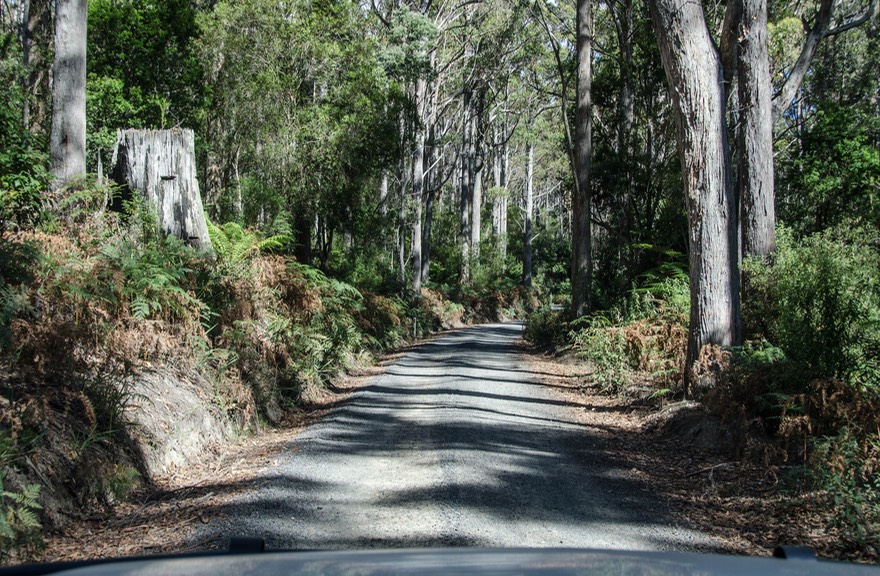
By now, we were getting really west, and we were quite pleased. We’d moved off pavement (bitumen as it’s known in these here parts) and onto dirt and gravel. We were among forests, near rivers and small bridges, and pretty much had the countryside all to ourselves. We puttered along for several days, occasionally wandering into a small hamlet but mostly staying in the middle of nowhere. We weathered a big storm, with lots of lightning, thunder and heavy rains, then the next day we stopped in at Marrawah, out on the west coast, looking for fuel at “the last fuel until Zeehan”. Turned out they had no power at all and didn’t look to see any soon. So they directed us back to Redpa, which wasn’t too far back and is presumably known as “the next to last fuel…”. We love it out here!
We headed south down the west coast, checking out rough and dramatic beaches, and then went through Arthur River, which doesn’t have any fuel, but does have a nice parks information office, some decent fish & chips, and tour boats navigating upstream a ways. Doesn’t seem that by this time of year they would be taking those boats all that far up the river. We’d been crossing the Arthur River regularly further inland, and it wasn’t all that much.
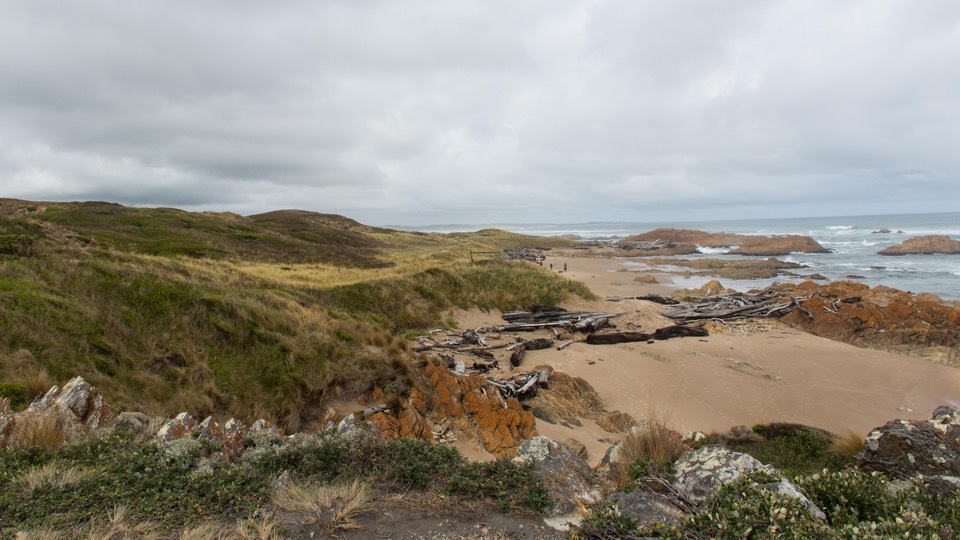
Poking along further, we arrived at Arthur-Pieman NP where Kathy wanted to check out some indigenous middens right off a beach she could reach — Indiana Jones we call her. They were cool, although in the grand scheme of things middens aren’t all that spectacular — surprise, surprise. They are basically just piles of shells. Built up over the centuries, they are large mounds, now covered with grasses. But nifty, she said.
We got to the end of the road, at least as far as we were allowed to drive without a permit, and then turned a bit further inland but always moving south — now along the famous/infamous Road to Nowhere. This is a bit of a rough dirt road, but not at all difficult. It heads down to Corinna (more on that in a minute), and goes through some nice forest. We’d been looking forward to driving it; with a name like that, how could we resist.
The weather had been threatening most of the past week and we’d just gotten started when the skies opened. Plenty of rain and even more wind. Not being quite sure what the conditions might be in case of heavy rains, we took a day off before proceeding further. It rained for much of the next day but cleared up nicely in the late afternoon.
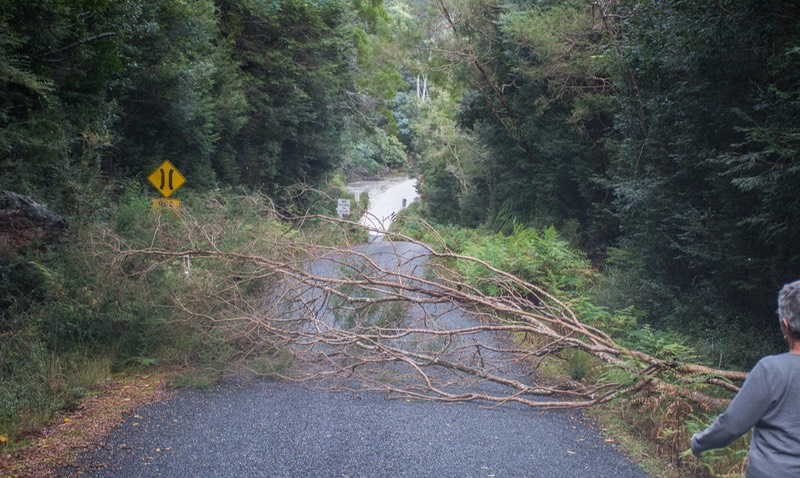
Back on the road the following morning, all was well, with the exception of a fairly large tree across the road, simply showing we were the first to be on the road after the big storm. We got busy trying to rip off smaller limbs and tug the trunk toward the side of the road, all while muttering about that chain saw that’s listed among the items every self-respecting 4WD operator always has on hand. Soon we were joined by another couple tooling along, and they jumped out to help. Together we cleared the road and proceeded on our way, eventually ending up in Corinna.
Now Corinna is rather special. It’s basically in the middle of nowhere, and likes it just fine, thank you. It used to house about 2500 miners (gold), but now just the occupants of a few huts and the people who run a well-respected eco-resort. There are walking trails, kayaking on the river, etc.; but the main deal (for us at least) is the “Fatman” barge that takes you across the river on a cable. We had to ring for the bargeman to come and carry us across the river, the Tiger filled it up entirely, and it was a great moment. We like little ferries. Great fun.
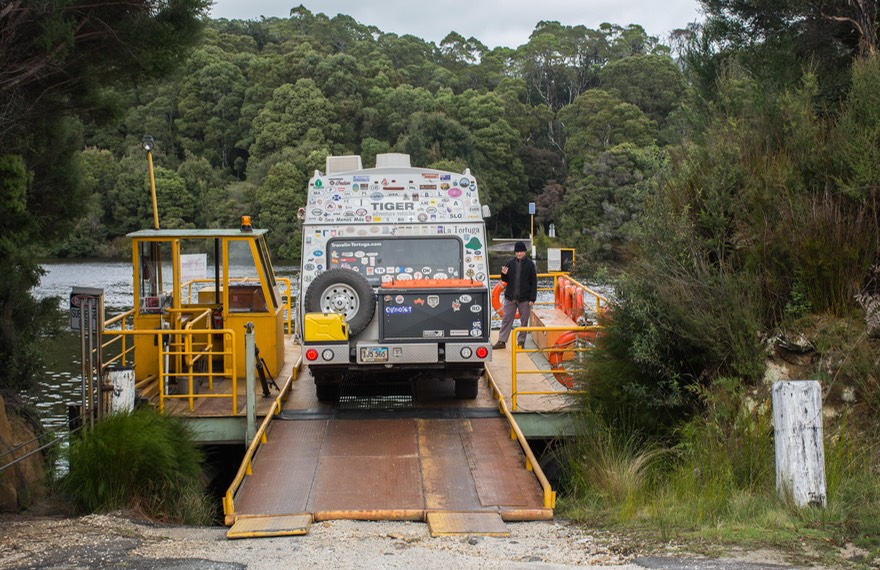
Below Corinna you fairly quickly rejoin the rest of the world. There are three small towns fairly close together — Zeehan, Strahan, and Queenstown — all with historic significance, nice little village centers, and plenty of tourism available. We enjoyed them, in part because it was late in the season and quiet, but we also had a sense that the best of Tassie was disappearing behind us in the mists. Probably the best adventure we had in that area was a “stroll” out to Strahan’s Hogarth Falls, at full force and quite stunning. The trip was completed in pouring rain, and the camera wouldn’t work worth a damn for quite awhile afterwards; but the pictures were rather neat, if somewhat damp. We kept moving along, and started east along the Lyell Highway, which would take us back in the direction of mainstream Tasmania.
East of the trio of towns we’d just visited, you enter the Franklin-Gordon Wild Rivers NP, which is highly touted as being a stunning drive. By this time, however, we have to admit that we’ve seen this same countryside several times, each time enjoying it a whole lot, and we weren’t overwhelmed; we wondered what we just weren’t noticing. As we traveled east, we came to the King William Saddle and a plaque saying that we were at the East-West Divide. Further west, which we were leaving, was wilderness and wet; further east the mountains would diminish, the land and forests would change, things would get drier and we would be in central Tasmania. And it became true sooner than you could blink. We dropped in altitude, it got warmer, the trees changed from extended rainforest to eucalypts, ferns were traded in on grazing cattle, and the landscape became drier. Just like that. Still pleasant, but no more drama.
We made a nice stop at Lake St Clair, the southern end of the Cradle Mountain-Lake St Clair NP. We walked along the lake, and up into the woods. A nice place and we had a good chat with one of the rangers, but it might have been more impressive to us earlier in our time in Tassie.
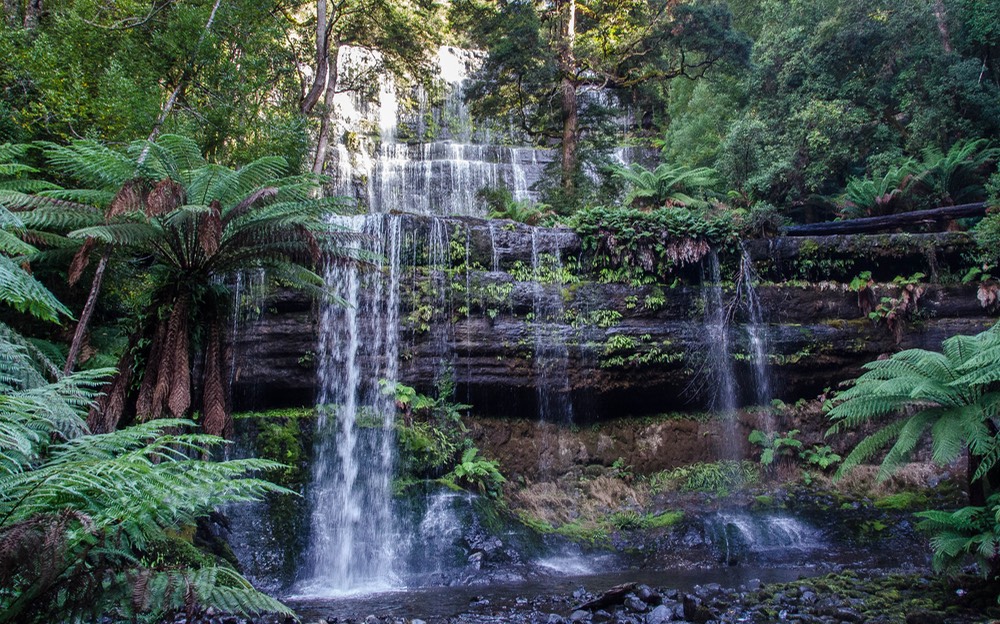
We had one last area to (re)visit before we finished our time here on the island. About a month earlier, we’d been in the Mount Field NP area, but had chosen to wait until later to do a bit of an explore. And now we had returned, to fall color everywhere. The grapes are ripe, there are zillions of bee boxes out in the woods, with very active hives — the bees come sniffing around the Tiger; they like his white color.
We spent some excellent time at Mount Field; it is well known as being a really lovely park, and it really is. We took the hike out to the iconic Russell Falls, and they are a beauty, as advertised; the prettiest falls and one of the nicest walks we’d taken. We had wanted to take a circuitous mountain drive up to Dobson Lake, because there are some special, very different pandani ferns there that needed to be seen, but the narrow road was being worked on and being used by very large trucks; we felt like we were sort of in the way, so we found a place to turn around and get out of the middle of things. Maybe another time.
We made a final stop at a fruit stand where we’d bought delicious, huge blackberries earlier in the season. This time we got delicious, huge raspberries; that’ll work! We also stopped in to the see the honey man in Bushy Park. We had bought honey from him earlier; Rick having announced it was the best honey he’d had since we were in Bulgaria, we stopped to get some more. We spent some time chatting with the man and his wife, both from Poland as it turns out. Lovely people, and delighted to see us again. It was a nice moment.
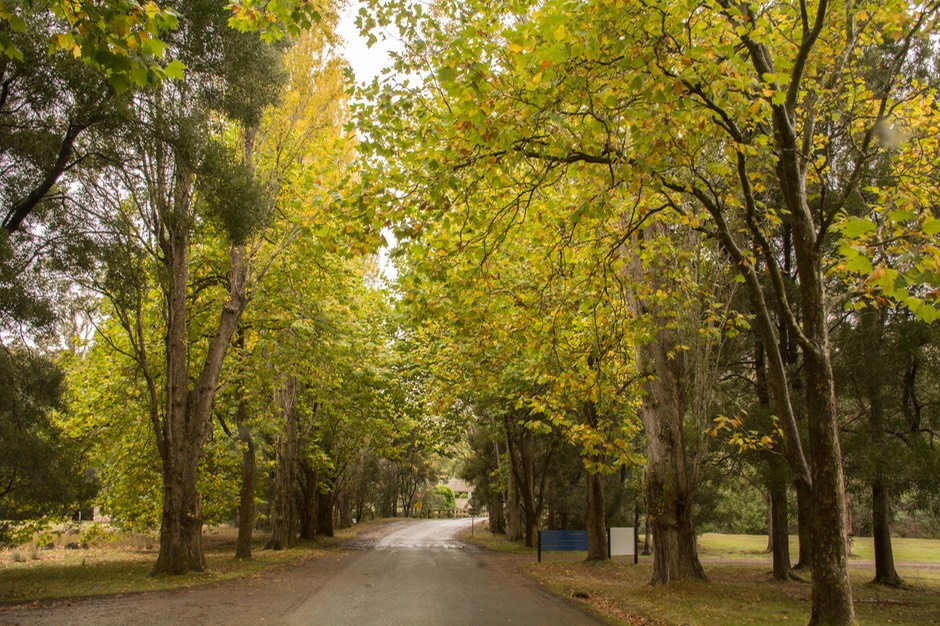
As we started back up the hill to the Devonport area, retracing our steps up through the Central Highlands, past the golf course in Bothwell, we were seeing more and more brilliant fall color in the trees. We were reminded that we’d just passed the one year anniversary of our arrival in New Zealand in late March 2017, and how we’d enjoyed the colors in the trees all through our stay there. Autumn is a fine time of year, with the lively colors contrasting with the generally barren look of the meadows and shrubs. Not too shabby; not too shabby at all.
Now here we are, writing to you and waiting for the ferry to load us aboard and take us back across the Bass Strait and over to Melbourne, on the “Big Island”, where our Aussie adventure will continue.
With a bit of time to spare before they began loading the boat, we shared some thoughts about our time here. Tasmania is lovely, and has lots of great places to visit. But maybe we’d stayed too long. Or maybe our time was simply too fragmented by the unplanned issues we had with our paperwork. Too often we needed to be here, or over there, or back here again. We struggled to develop the comfortable flow we enjoy so much in our travels.
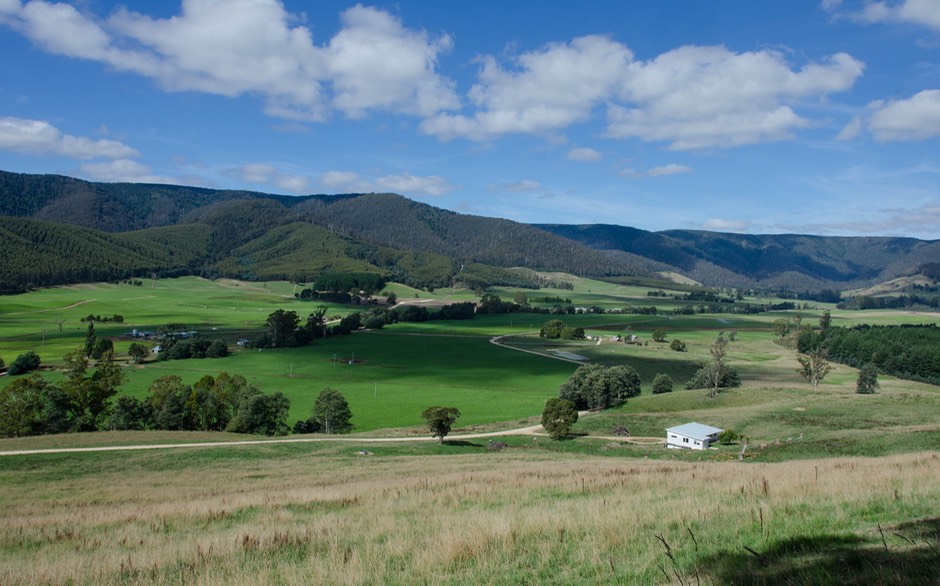
In asking others “How long do you need?” we were often reminded that Tassie is a small island that has a whole lot to see. Among other things, there are a number of UNESCO World Heritage sites here; they actually comprise roughly 20% of the land area of the state. We’d been told a month should do it, but take more if you’ve got more. This would especially be the case if you were into hiking. Hikers love Tassie, and for good reason; it’s a hiker’s paradise, but long hikes take careful planning, and weather is a large factor. To us, rainstorms merely mean we have time to catch up on the housework, but if you want to be out hiking the vast western forests weather can really slow you down.
Another factor is Tasmania’s settlement history, and there are many places to see if you are so inclined. We have less interest than many in the arrival of the convicts and soldiers and prisons, followed by the colonial settlers. All of that is important, of course, and you can spend a great deal of time visiting sites and learning the history of the white settlement of the island. Unfortunately, that settlement history includes some very poor treatment of the Aborigines who lived there when the europeans arrived. In addition to suffering the same attacks of disease and aggression as the indigenous peoples on the mainland, at one point they were all gathered up and moved to an island offshore where they eventually perished. In our learning about Australia’s history we’ve tried pretty hard to move beyond that time.
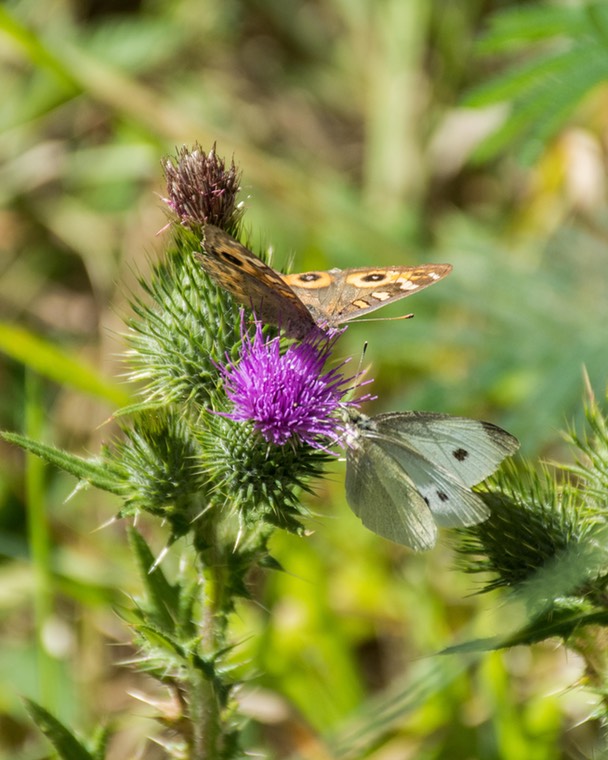
Tasmania is a charming, beautiful island, with a strong tourist draw and all of the plusses and minuses that implies. Without the tourists, the island’s economy would likely falter. As it is it cannot support itself, and is dependent on a combination of visitor monies and help from the national government. It has significant infrastructure issues; most of the roads were built too long ago and they are narrow and in poor condition. There are strong agricultural bases here, with excellent wines in production and many exported products. But it’s the tourist money that keeps them going. As a result, tourism perhaps weighs too heavily in the decision-making process. Small quiet areas get discovered and adventure tourism blossoms, bringing traffic, development, all the usual. It’s very similar to the issues we experienced last year in New Zealand; popularity comes with a cost. As with many other places we’ve been, we wish we’d been here 10 years before.
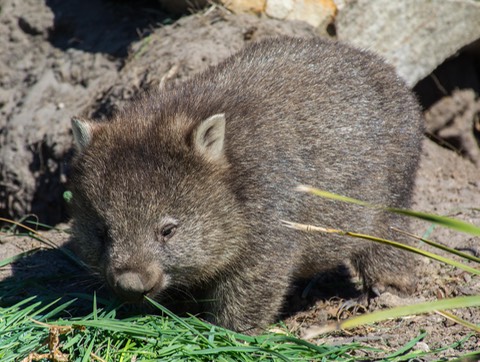
And along the way we learned that, sadly, there are no more Tasmanian Tigers; they became extinct around a hundred years ago. So we were happy that we’d brought along our own Tiger and were able to loan him to Tasmania for a short time; as Tasmania loaned herself to us. And we loved the animals, and the birds, and the magnificent rain forests filled with ferns and mossy tree trunks dripping with water. We met wombats and devils and quolls, and there are kookaburras here, lots of them; most mornings we can sit in a forest in the Tiger and hear them discussing the issues of the day.
So yes, it’s been a good visit.
More soon, from Rick, Kathy and Himself, all at sea, yet again.
Go to our Photo Gallery for Tasmania